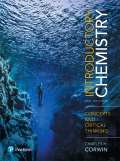
(a)
Interpretation:
The direction of the equilibrium with the increase in the concentration of
Concept introduction:
In a
It is represented as
Also, the concentration of liquid and solid is not considered in the equilibrium constant expression.
(b)
Interpretation:
The direction of the equilibrium with the decrease in the concentration of
Concept introduction:
In a chemical reaction, when the rate of both forward and reverse reaction are equal. Then the chemical reaction is in equilibrium. In other words, their concentration does not vary with the time change. They are reversible in nature.
It is represented as
Also, the concentration of liquid and solid is not considered in the equilibrium constant expression.
(c)
Interpretation:
The direction of the equilibrium with the increase in the
Concept introduction:
In a chemical reaction, when the rate of both forward and reverse reaction are equal. Then the chemical reaction is in equilibrium. In other words, their concentration does not vary with the time change. They are reversible in nature.
It is represented as
Also, the concentration of liquid and solid is not considered in the equilibrium constant expression.
(d)
Interpretation:
The direction of the equilibrium with the decrease in the
Concept introduction:
In a chemical reaction, when the rate of both forward and reverse reaction are equal. Then the chemical reaction is in equilibrium. In other words, their concentration does not vary with the time change. They are reversible in nature.
It is represented as
Also, the concentration of liquid and solid is not considered in the equilibrium constant expression.
Want to see the full answer?
Check out a sample textbook solution
Chapter 16 Solutions
EBK INTRODUCTORY CHEMISTRY
- . What does it mean to say that a state of chemical or physical equilibrium is dynamic?arrow_forwardFor the following reactions, predict whether the pressure of the reactants or products increases or remains the same when the volume of the reaction vessel is increased. (a) H2O(l)H2O(g) (b) N2(g)+3H2(g)2NH3(g) (c) C2H4(g)+H2O(g)C2H5OH(g)arrow_forward5.3) write the expression for the equilibrium constant of the following reactionarrow_forward
- Hydrogen and iodine gas react to produce hydrogen iodide gas. What is the value of Keq for this reaction if at equilibrium the concentration of H2, I2 and HI were 0.25M, 0.035M, and 0.55M respectively?arrow_forwardLe Chatelier’s Principle states that when a system is at equilibrium it is subjected to stress, the system will shift its equilibrium point in order to relieve the stress. Complete the following chart by indicating the shift for the equilibrium (⤾or⤿) and whether the other values increase (↑), decrease (↓) or remain unchanged (-). N2(g) + 3H2(g) ⇆ 2NH3(g) + heatarrow_forwardWrite the equation for the equilibrium constant for each .arrow_forward
 Chemistry: Principles and ReactionsChemistryISBN:9781305079373Author:William L. Masterton, Cecile N. HurleyPublisher:Cengage Learning
Chemistry: Principles and ReactionsChemistryISBN:9781305079373Author:William L. Masterton, Cecile N. HurleyPublisher:Cengage Learning World of Chemistry, 3rd editionChemistryISBN:9781133109655Author:Steven S. Zumdahl, Susan L. Zumdahl, Donald J. DeCostePublisher:Brooks / Cole / Cengage Learning
World of Chemistry, 3rd editionChemistryISBN:9781133109655Author:Steven S. Zumdahl, Susan L. Zumdahl, Donald J. DeCostePublisher:Brooks / Cole / Cengage Learning Introductory Chemistry: A FoundationChemistryISBN:9781337399425Author:Steven S. Zumdahl, Donald J. DeCostePublisher:Cengage Learning
Introductory Chemistry: A FoundationChemistryISBN:9781337399425Author:Steven S. Zumdahl, Donald J. DeCostePublisher:Cengage Learning


